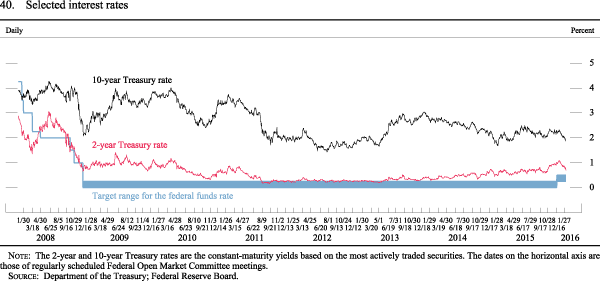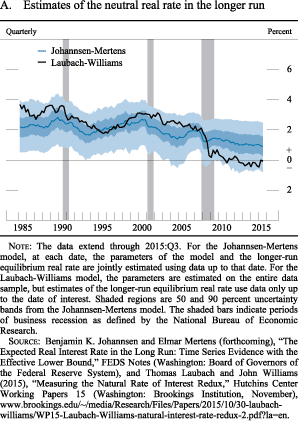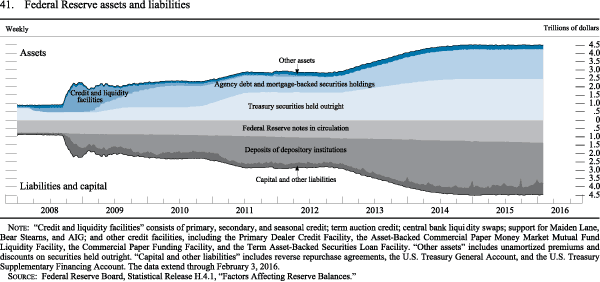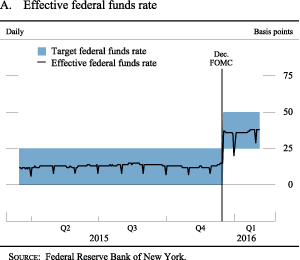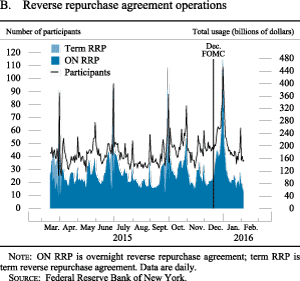- February 10, 2016: Summary
- Part 1
- Part 2
- Part 3
- Abbreviations
- Printable Version (1.2 MB PDF)

Part 2: Monetary Policy
Monetary Policy Report submitted to the Congress on February 10, 2016, pursuant to section 2B of the Federal Reserve ActIn December, the Federal Open Market Committee (FOMC) raised the target range for the federal funds rate by 1/4 percentage point after seven years in which that rate had been held near zero. The FOMC's decision reflected the considerable improvement in the labor market last year and the Committee's assessment that, even with the modest reduction in policy accommodation, the labor market would continue to strengthen and inflation would return over the medium term to the FOMC's 2 percent objective. Monetary policy remains accommodative, and the Committee expects that economic conditions will warrant only gradual increases in the federal funds rate. However, the actual path of the federal funds rate will depend on the economic outlook as informed by incoming data.
The FOMC raised the federal funds rate target range in December...
Since last March, the FOMC had anticipated that it would be appropriate to increase the federal funds rate when it had seen further improvement in the labor market and was reasonably confident that inflation would move back to 2 percent over the medium term. In December, the FOMC, judging that these criteria had been met, raised the target range for the federal funds rate to 1/4 to 1/2 percent (figure 40). 4
The Committee's decision to raise the federal funds rate recognized the time it takes for policy actions to affect future economic outcomes; if the FOMC delayed the start of policy normalization for too long, a relatively abrupt tightening of policy might eventually be needed to keep the economy from overheating and inflation from significantly overshooting the Committee's 2 percent objective. Such an abrupt tightening could disrupt financial markets and perhaps even inadvertently push the economy into recession.
...but monetary policy remains accommodative
Even after the increase in the federal funds rate late last year, the stance of monetary policy remains accommodative. The FOMC anticipates that economic conditions will evolve in a manner that will warrant only gradual increases in the federal funds rate, and that the federal funds rate is likely to remain, for some time, below the levels that are expected to prevail in the longer run.
This expectation is consistent with the view that the neutral nominal federal funds rate--defined as the value of the federal funds rate that would be neither expansionary nor contractionary if the economy was operating at its productive potential--is currently low by historical standards and is likely to rise only gradually over time. One indication that the neutral federal funds rate is low is that U.S. economic growth has been only moderate in recent years despite the very low level of the federal funds rate and the Federal Reserve's very large holdings of longer-term securities. Had the neutral rate been running closer to the average level estimated to have prevailed in recent decades, these policy actions would have been expected to foster a much more rapid economic expansion.
An array of persistent economic headwinds have weighed on aggregate demand since the financial crisis; these headwinds included, at various times, limited access to credit for some borrowers, contractionary fiscal policy, and weak growth abroad coupled with a significant appreciation of the dollar. Although the overall restraint imposed by such headwinds has declined over the past few years, the effects of some headwinds have remained significant. As these effects abate further, the neutral federal funds rate should gradually move higher over time. (For a discussion of how the neutral federal funds rate is likely to evolve over time, see the box "The Neutral Federal Funds Rate in the Longer Run.")
Another reason that the Committee expects only a gradual increase in the federal funds rate will be warranted is that, with the federal funds rate near zero, the FOMC can respond more readily to upside surprises to inflation, economic growth, and employment than to downside shocks. This asymmetry suggests that it is appropriate to be more cautious in normalizing the stance of monetary policy than would be the case if short-term nominal interest rates were appreciably above zero.
In part reflecting this concern, the FOMC continued to reinvest principal payments from its securities portfolio, and the Committee expects that this reinvestment policy will be maintained until normalization of the level of the federal funds rate is well under way. Maintaining sizable holdings of longer-term securities should help support accommodative financial conditions and reduce the risk that the Committee would not be able to deliver sufficient accommodation by lowering the federal funds rate in the event of future adverse shocks.
The FOMC expects that, supported by an accommodative monetary policy, economic activity will continue to expand at a moderate pace and the labor market will continue to strengthen. Inflation is expected to remain low in the near term, in part because of recent further declines in energy prices, but to rise to 2 percent over the medium term as the transitory effects of declines in energy and import prices dissipate and the labor market strengthens further. In light of the current shortfall of inflation from 2 percent, the Committee is carefully monitoring actual and expected progress toward its inflation goal.
The Neutral Federal Funds Rate in the Longer Run
As discussed in the main text, economic growth has been only moderate in recent years despite the very low level of the federal funds rate and the Federal Reserve's large-scale purchases of longer-term securities. This observation suggests that headwinds have lowered the "neutral" federal funds rate--defined as the value of the federal funds rate that would be neither expansionary nor contractionary if the economy was operating at its productive potential--to historically low levels.
As economic disturbances dissipate, the neutral federal funds rate should rise to its expected longer-run level. This longer-run value of the neutral rate plays an important role in monetary policy analysis: It is a key determinant of the longer-run level of the federal funds rate and other nominal interest rates. When expressed on a real basis, it also corresponds to the intercept of simple policy rules such as those studied in Taylor (1993).1 Like the current neutral rate, the longer-run value of the neutral rate is not directly observed and must be estimated using the available data and potentially imperfect models of the economy.
Since 2012, the median of the projections of the longer-run level of the federal funds rate in the Federal Open Market Committee's Summary of Economic Projections has fallen from 4.25 percent to 3.50 percent.2 In addition, several econometric studies have estimated a decline in the longer-run value of the neutral rate by statistically modeling the co-movements between variables like inflation, interest rates, output, and unemployment.3 Figure A shows estimates from two time-series models of the longer-run value of the neutral rate, expressed on a real basis. One is from Johannsen and Mertens (forthcoming), and the other is from Laubach and Williams (2015).4 The figure includes the uncertainty bands for the Johannsen and Mertens estimates, which indicate that the uncertainty surrounding the longer-run value of the neutral rate is substantial (as it is in other model frameworks).
Uncertainty about the longer-run value of the neutral rate implies uncertainty about the expected cumulative rise in policy rates during the policy normalization process. The risk that the longer-run value of the neutral rate going forward could be lower than currently estimated is especially pertinent, because such a scenario would likely increase the probability that monetary policy will be constrained by the effective lower bound on nominal interest rates in the future, with adverse consequences for macroeconomic outcomes.
Footnotes
1. See John B. Taylor (1993), "Discretion versus Policy Rules in Practice," Carnegie-Rochester Conference Series on Public Policy, vol. 39 (December), pp. 195-214. Return to text
2. See the December 2015 Summary of Economic Projections, which appeared as an addendum to the minutes of the December 15-16, 2015, meeting of the Federal Open Market Committee and is included as Part 3 of this report. Return to text
3. See, for example, Benjamin K. Johannsen and Elmar Mertens (forthcoming), "The Expected Real Interest Rate in the Long Run: Time Series Evidence with the Effective Lower Bound," FEDS Notes (Washington: Board of Governors of the Federal Reserve System); Michael T. Kiley (2015), "What Can the Data Tell Us about the Equilibrium Real Interest Rate?" Finance and Economics Discussion Series 2015-077 (Washington: Board of Governors of the Federal Reserve System, August), www.federalreserve.gov/econresdata/feds/2015/files/2015077pap.pdf; Thomas Laubach and John Williams (2015), "Measuring the Natural Rate of Interest Redux," Hutchins Center Working Papers 15 (Washington: Brookings Institution, November), www.brookings.edu/~/media/Research/Files/Papers/2015/10/30-laubach-williams/WP15-Laubach-Williams-natural-interest-rate-redux-2.pdf?la=en ![]() ; and Thomas A. Lubik and Christian Matthes (2015), "Calculating the Natural Rate of Interest: A Comparison of Two Alternative Approaches," Economic Brief 15-10 (Richmond: Federal Reserve Bank of Richmond, October), https://www.richmondfed.org/~/media/richmondfedorg/publications/research/economic_brief/2015/pdf/eb_15-10.pdf
; and Thomas A. Lubik and Christian Matthes (2015), "Calculating the Natural Rate of Interest: A Comparison of Two Alternative Approaches," Economic Brief 15-10 (Richmond: Federal Reserve Bank of Richmond, October), https://www.richmondfed.org/~/media/richmondfedorg/publications/research/economic_brief/2015/pdf/eb_15-10.pdf ![]() . In these studies, the longer-run value of the neutral rate is sometimes referred to as the longer-run value of the "natural" rate or the longer-run "equilibrium" federal funds rate. Return to text
. In these studies, the longer-run value of the neutral rate is sometimes referred to as the longer-run value of the "natural" rate or the longer-run "equilibrium" federal funds rate. Return to text
4. The estimates from the Johannsen-Mertens and Laubach-Williams models are not the same because the models use different data to infer slack in the economy and because the model restrictions and estimation methods are different. Return to text
The FOMC's policy decisions will continue to be data dependent
Although the Committee expects that economic conditions will warrant only gradual increases in the federal funds rate, the Committee has emphasized that the actual path of monetary policy will depend on how incoming data affect the economic outlook. In determining the timing and size of future adjustments to the target range, the Committee will assess realized and expected economic conditions relative to its objectives of maximum employment and 2 percent inflation. Stronger growth or a more rapid increase in inflation than the Committee currently anticipates would likely call for faster increases in the federal funds rate; conversely, if conditions prove weaker, a lower path of the federal funds rate would likely be appropriate. Similarly, the timing of a change in the reinvestment policy will depend on economic developments and their implications for progress toward the FOMC's goals of maximum employment and price stability. In assessing realized changes in economic conditions and forming its outlook, the Committee will take into account a wide range of measures, including measures of labor market conditions, indicators of inflation pressures and inflation expectations, and readings on financial and international developments.
The size of the Federal Reserve's balance sheet has remained stable
With the continuation of the Committee's reinvestment policy, the Federal Reserve's total assets have held steady at around $4.5 trillion (figure 41). Holdings of U.S. Treasury securities in the System Open Market Account (SOMA) have remained at $2.5 trillion, and holdings of agency debt and agency mortgage-backed securities at approximately $1.8 trillion. Consequently, total liabilities on the Federal Reserve's balance sheet were largely unchanged.
Given the Federal Reserve's large securities holdings, interest income on the SOMA portfolio has continued to support substantial remittances to the U.S. Treasury Department. Preliminary results indicate that the Reserve Banks provided for payments of $97.7 billion of their estimated 2015 net income to the Treasury. In addition, the Reserve Banks transferred to the Treasury $19.3 billion from their capital surplus as required by an amendment to the Federal Reserve Act contained in the Fixing America's Surface Transportation Act of 2015. Remittances from 2008 through 2015 total about $600 billion on a cumulative basis--an average of about $75 billion a year, compared with about $25 billion a year, on average, over the decade prior to 2008.
The Committee continued to focus on the implementation of monetary policy
Consistent with the FOMC's Policy Normalization Principles and Plans published on September 17, 2014, the Federal Reserve used interest paid on reserve balances and also employed an overnight reverse repurchase agreement (ON RRP) facility to implement its decision in December to raise the target range for the federal funds rate.5 Specifically, the Board of Governors raised the interest rate paid on required and excess reserve balances to 1/2 percent, while the FOMC authorized ON RRP operations at an offering rate of 1/4 percent. (For further information, see the box "Monetary Policy Implementation following the December 2015 FOMC Meeting.") In addition, the Board of Governors approved an increase in the discount rate (the primary credit rate) to 1 percent.
Along with the decision to increase the target range for the federal funds rate, the FOMC also temporarily suspended the aggregate cap on ON RRP transactions, indicating that ON RRP operations would be undertaken in amounts limited only by the value of Treasury securities held outright in the SOMA that are available for such operations and by a per-counterparty limit of $30 billion per day. Nonetheless, total reverse repurchase agreement transactions with the Federal Reserve have remained near levels observed prior to the increase in the target range for the federal funds rate and the suspension of the aggregate cap. The Committee intends to phase out this facility when it is no longer needed to help control the federal funds rate.
The Federal Reserve also continued to test the operational readiness of other policy tools. Three Term Deposit Facility operations were conducted in the second half of 2015. The operations offered either 7- or 14-day deposits at a floating rate of 1 basis point over the interest rate on excess reserves. In these operations, deposit volumes declined slightly from previous tests with similar parameters.
Monetary Policy Implementation following the December 2015 FOMC Meeting
At its December 2015 meeting, the Federal Open Market Committee (FOMC) increased the target range for the federal funds rate from between 0 and 1/4 percent to between 1/4 and 1/2 percent, effective December 17.1 In order to implement the monetary policy stance announced in December, the Board of Governors also voted to raise the interest rate paid on required and excess reserve balances to 0.50 percent. Moreover, the FOMC authorized an increase in the overnight reverse repurchase agreement (ON RRP) facility offering rate to 0.25 percent and indicated that the aggregate amount of the ON RRP operations would be constrained only by the value of Treasury securities held outright in the System Open Market Account that are available for such operations.2 Each of these monetary policy decisions is consistent with the guidance provided in the Policy Normalization Principles and Plans outlined in the July 2015 Monetary Policy Report.3
The effective federal funds rate rose to 0.37 percent at the time of the change to the target range for the federal funds rate amid orderly trading conditions in money markets (figure A). Since the increase in the target range, the effective federal funds rate has traded in a relatively narrow range of 0.35 to 0.38 percent, with the exception of month-ends, when the rate fell temporarily in typical fashion. Increases in interest rates in other money markets were similar to the rise in the federal funds rate following the December meeting, with overnight Eurodollar rates closely tracking the effective federal funds rate and the general collateral repurchase agreement (or repo) rate maintaining spreads to unsecured rates similar to those observed before the December meeting.
Total volume in the ON RRP facility was virtually unchanged on the day after the December meeting (figure B). In the weeks following the December meeting, the total amount of Federal Reserve reverse repurchase agreement (RRP) operations reflected typical calendar-related effects. On year-end, volume in the ON RRP facility was nearly $475 billion, roughly in line with aggregate RRP operations seen on recent quarter-ends. Following year-end, usage of the ON RRP facility rapidly returned to--and has remained at--levels that prevailed before year-end, consistent with recent quarter-end patterns.
Footnotes
1. See Board of Governors of the Federal Reserve System (2015), "Federal Reserve Issues FOMC Statement," press release, December 16, www.federalreserve.gov/newsevents/press/monetary/20151216a.htm. Return to text
2. In a related action, the Board of Governors voted to approve a 1/4 percentage point increase in the discount rate to 1 percent. Return to text
3. See the box "Policy Normalization Principles and Plans: Additional Details" in Board of Governors of the Federal Reserve System (2015), Monetary Policy Report (Washington: Board of Governors, July), p. 35, www.federalreserve.gov/monetarypolicy/files/20150715_mprfullreport.pdf. Return to text
Footnotes
4. See Board of Governors of the Federal Reserve System (2015), "Federal Reserve Issues FOMC Statement," press release, December 16, www.federalreserve.gov/newsevents/press/monetary/20151216a.htm. Return to text
5. See Board of Governors of the Federal Reserve System (2014), "Federal Reserve Issues FOMC Statement on Policy Normalization Principles and Plans," press release, September 17, www.federalreserve.gov/newsevents/press/monetary/20140917c.htm. Return to text

